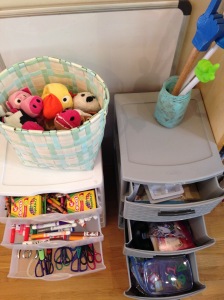
Dear Me,
I am writing to you from the future, in the year 2021. It’s early March, and as I look outside my living room window the world looks basically as it always has. The sky is shades of platinum that only a Seattleite knows how use to interpret the day’s upcoming weather. Our crocuses, resilient little things, emerged from the damp soil in our garden this week, despite my intentional neglect of all living things that don’t reside under my own roof. Woodpeckers frequent the giant cedar tree outside my kitchen window. It’s only a matter of time before they move over to our neighbor’s aging basketball hoop to show off to their would-be mates, their beak-on-metal birdsongs acting as our daily 5AM alarm. Our grass is starting to look like it needs mowing (Even though it’s full of giant 6-foot deep septic test holes, but that’s another story back-then-you doesn’t have to face yet so I’ll spare you the drama.). And even though the view from my window looks commonplace, this year has been anything but.
You don’t know this yet, but change–MONUMENTAL change–is coming. I don’t want to jinx the time-space continuum or anything, so I won’t tell you exactly what’s going on. But know this: this last year has been the strangest, scariest, saddest, self-stretch-iest time I’ve ever experienced in my life. There will be days that you experience first-hand what it feels like to be hanging on with just your fingernails at the end of your rope. And there will be days of self-discovery that make every struggle, every sacrifice worth it all. This year will tear apart your world–it will tear apart the world–but you will survive. And you will thrive. Because pain is part of the process of metamorphosis.
During The Big Change you will do things you never thought you could do. You will do things you said you would never do.
Like homeschooling.
That’s right. Homeschooling.
As in, your kids won’t enter a school building for an entire year and the classroom will move to your couch. And you’ll try to teach them and they’ll try to learn from you and some days you’ll get it all right and other days you’ll just notice all the gray hairs you’ve accumulated in the homeschool classroom. You’ll experience the elated joys of those “A-ha! Moments” that drove you to be a teacher decades ago. You’ll experience the despair of long-division and subtraction with regrouping. You’ll teach the kids vital life lessons like how to care for their own bodies and minds and souls. You’ll also teach them how to be bored (Lot’s of time for that with The Big Change!), how to scrub toilets (I miss our monthly housecleaner with the same ferocity that I miss sunshine in the middle of February.), and to just leave me the heck alone if the bathroom door is locked (Don’t tell them I hide chocolate in the top right drawer of the vanity.).
And through this homeschooling process, you’ll discover your kids in whole new ways. Some of the most important learning you’ll do during The Big Change is about these little people and what drives them and what they need out of you and out of life. You’ll realize some things your kids really needed that they weren’t getting before–the pieces of the puzzle just didn’t fit together until you spent all day, every day together without interruption for an entire year. And you’ll have enough fortitude after The Big Change to embark on some difficult journeys with your kids that you didn’t have the strength or the drive to face before. It will be hard and it will be good and it will be necessary. And you’ll all be better for it.
Speaking of homeschooling, you’ll get to see a lot of your kids during The Big Change. I don’t know if I should tell you this yet because you’re probably going to freak out, but basically *you and your kids won’t leave your house for an entire year*. Forget travel, concerts, museums, and restaurants. Even the little things will seem huge to you after The Big Change. You’ll look back fondly on the good ‘ol days when you could have daily adventures like dropping the kids off at school, going inside a physical store to do your grocery shopping, and visiting with the neighborhood moms at the bus stop every afternoon. The inside of Costco will feel like a distant dream of Nirvana.
The walls of your home will become your personal fortress and you’ll do everything you can to make it feel right. You’ll spend an unfathomable number of hours and dollars building a sound-proof home theater that doubles as an entertainment venue and a family-evading escape room. You’ll start meeting with an architect to draw up plans to blow up one whole side of the house and create an oasis in its wake. You’ll discover that new septic systems cost twice as much as new cars, but are at least half as much fun. A therapist-suggested “Mindfulness Exercise” will set you into a panic attack when you become mindful of the scuffs and dust and grime that cover every square inch of your home. You’ll leave the Christmas lights on the house year-round simply because they’re bright and they make you happy. Your home will become so much more than a home. It will, in a sense, become your whole world during The Big Change.
Your home will also become your husband’s workplace. You know how he’s always said that he wanted to work from home, and when we bought this house he insisted on having his own room that he could claim as his office *just in case* he ever got to work from home? Well, his dream came true (Maybe we’ll blame him for what happened next). Hubby has been working at home every day for over a year now, and he’s in paradise. Seriously, this is one of the best things that could have happened to him. Future Hubby will love not having to commute. He’ll love shutting his office door and having nobody interrupt him for hours on end. He’ll love having a recliner in his office where he can read and take naps during his breaks. He’ll be the happiest, most productive version of himself.
And you’ll be happier for the work-from-home scenario, too. He’ll be home with the kids if you need to run out of the house for an errand or a walk or a good cry in your car (this happens with regularity during The Big Change). He’ll be less stressed, and that energy will pass on to you and the kids. He’ll pop upstairs for lunch and breaks and you’ll get to connect in shared moments that you’ve never had in your entire 15-year marriage. You’ll see his incredible work ethic played out every single day, and you’ll love him more for it. It will be a serendipitous outcome from a most unexpected change.
There will be other unexpected positives that come out of The Big Change. You know those neighbors who you’ve always loved but hadn’t gotten to spend much time with before? Those neighbors will essentially become a second family to you. They’ll walk through life’s biggest challenges with you, give your kids a vital social outlet, celebrate milestones with you, and lend you rolls of toilet paper when there’s not a scrap of T.P. to be found on the planet (Don’t even get me started on this one. But maybe you should start amassing a significant supply of toilet paper and stockpile it in your basement. You know, just in case future-you might need it or something.).
You’ll make sacrifices for the greater good, and this altruism will color every aspect of your life. You’ll be more humbled and more grateful than you’ve ever been before. You’ll be reminded that you are not in control, and that’s exactly where you’re supposed to be.
You’ll connect with nature when the great outside becomes your only outlet. You’ll walk hundreds of miles around your neighborhood and the fields behind your house. You’ll eat dinner across the deck from your best friends in the middle of December just so you can do something “normal”, frostbitten fingers aside. You’ll embrace the (admittedly terrible) weather, and every member of your family will own full rain-proof regalia so you can venture outside even when none of you wants to.
You’ll wear one of three versions of the same outfit every day, and you won’t change out of yoga pants for a year (I don’t know if this is a good thing or a bad thing, but you’ll be the most comfortable self you’ve ever been).
You’ll learn new Big Change vocabulary: unprecedented (We’re going to try something we’ve never tried before, and we’ll just see how it goes); robust (multi-faceted systems that continue to be multi-faceted and we will continually point out their multi-faceted-ness); asynchronous (the old-school pre-recorded setting on your DVR); “out of an abundance of caution” (This shtuff is super scary and super overwhelming and we don’t understand it at all so we’ve gotta shut it all down NOW!); Zoom (a necessary evil); maskless (selfish); essential worker (someone who can’t do their job from behind a screen); birthday parade (A 5-minute drive-by birthday party. See also: best invention for over-stressed parents EVER.); social distancing (people actually respecting your bubble of personal space); vaccine (liquid gold).
And through it you’ll persevere. It will be the strangest, scariest, saddest, self-stretch-iest time you’ve ever experienced in your life, but you will hold on to what is most important: Your health, the helpers and the helping, and your hope. By the end of the first year of The Big Change you’ll start to see the light at the end of the tunnel. The darkest days will be behind you, and the end will be in sight. So you’ll continue to persevere with hope for the better days that lay ahead. Because life–no matter how unprecedented it may be–will always be worth living well.
Love,
Me



















